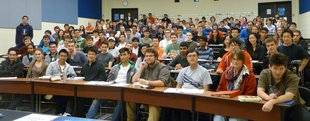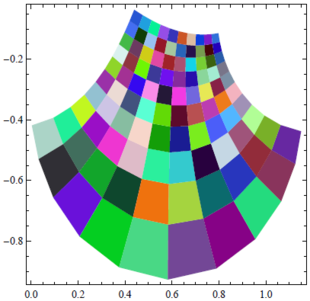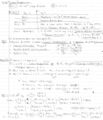12-240/Classnotes for Thursday October 18: Difference between revisions
From Drorbn
Jump to navigationJump to search
No edit summary |
|||
| Line 1: | Line 1: | ||
{{12-240/Navigation}} |
{{12-240/Navigation}} |
||
'''== Linear transformation ==''' |
'''== Linear transformation ==''' |
||
| ⚫ | |||
'''Definition:''' |
|||
| ⚫ | |||
1) L(x + y)= L(x) + L(y) |
1) L(x + y)= L(x) + L(y) |
||
| Line 15: | Line 18: | ||
2) L: V -> W is a linear transformation iff <math>\forall\,\!</math> c <math>\in\,\!</math> F, <math>\forall\,\!</math> x, y <math>\in\,\!</math> V: L(cx + y)= cL(x) + L(y) |
2) L: V -> W is a linear transformation iff <math>\forall\,\!</math> c <math>\in\,\!</math> F, <math>\forall\,\!</math> x, y <math>\in\,\!</math> V: L(cx + y)= cL(x) + L(y) |
||
'''Proof: |
'''Proof:''' |
||
''' |
|||
1) take c= 0 in F and x=0 in V. Then L(cx)=cL(x) -> L(0 of F * 0 of V)=(0 of F)*L(0 of V)=0 of W |
1) take c= 0 in F and x=0 in V. Then L(cx)=cL(x) -> L(0 of F * 0 of V)=(0 of F)*L(0 of V)=0 of W |
||
2)(=>)Assume L is linear transformation |
2)(=>)Assume L is linear transformation |
||
L(cx + y)= L(cx) + L(y)= c*L(x) + L(y) |
|||
(<=) 1. Follows from L(c*x+y) = c*L(x)+L(y) by taking c=1 |
|||
2. Follows by taking y=0 |
|||
2. Follows by taking y=0 |
|||
'''Examples''' |
'''Examples''' |
||
Revision as of 14:29, 8 November 2012
| |||||||||||||||||||||||||||||||||||||||||||||||||||||||||
== Linear transformation ==
Definition:
A function L: V-> W is called a linear transformation if it preserve following structures:
1) L(x + y)= L(x) + L(y)
2) L(cx)= c.L(x)
3) L(0 of V) = 0 of W
Proposition:
1) property 2 => property 3
2) L: V -> W is a linear transformation iff c F, x, y V: L(cx + y)= cL(x) + L(y)
Proof:
1) take c= 0 in F and x=0 in V. Then L(cx)=cL(x) -> L(0 of F * 0 of V)=(0 of F)*L(0 of V)=0 of W
2)(=>)Assume L is linear transformation
L(cx + y)= L(cx) + L(y)= c*L(x) + L(y)
(<=) 1. Follows from L(c*x+y) = c*L(x)+L(y) by taking c=1
2. Follows by taking y=0
Examples
1. L: R^2 -> R^2 by
2. P,Q: P(F)







